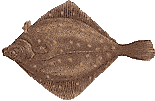BUYING GUIDE FOR FRESH FISH
- Flesh - The flesh should be firm and elastic to the touch, and should not be separating from the bone. Fillets should have a fresh-cut appearance and the color should resemble freshly filleted fish.
- Appearance - Fresh fillets, steaks, chunks, cuts, etc. should look moist, firm, and practically free of any brownish streaks throughout the meat. If, when you press your finger into the flesh, there is an indentation that fills with liquid, or if there is excessive liquid in the package, the fish has probably been frozen and thawed.
- Eyes - If present, the eyes should be bright, clear, transparent, full, and protruding. As fresh fish ages, the eyes will become cloudy and sunken and often turn pink.
- Gills - If present, the gills should be bright red and free of slime. As the fish begins to deteriorate, the gills change color, fading to a pink, then gray. Eventually they will become brownish and greenish.
- Skin - The skin should be vibrant and bright. Any skin markings (color, spots, stripes) should be distinct;
- To Clean a Fish:
- Fish are cleaned and dressed at market as ordered, but need additional cleaning before cooking. Remove scales, which have not been taken off. This is done by drawing a knife over fish, beginning at tail and working towards head, occasionally wiping knife and scales from fish. Incline knife slightly towards you to prevent scales from flying. The largest number of scales will be found on the flank. Wipe thoroughly inside and out with cloth wrung out of cold water, removing any clotted blood which may be found adhering to backbone. Head and tail may or may not be removed, according to size of fish and manner of cooking. Small fish are generally served with head and tail left on.
- To Skin a Fish:
- With sharp knife remove fins along the back and cut off a narrow strip of skin the entire length of back. Loosen skin on one side from bony part of gills, and being once started, if fish is fresh, it may be readily drawn off; if flesh is soft do not work too quickly, as it will be badly torn. By allowing knife to closely follow skin this may be avoided. After removing skin from one side, turn fish and skin the other side.
- To Bone a Fish:
- Clean and skin before boning. Beginning at the tail, run a sharp knife under flesh close to backbone, and with knife follow bone (making as clean a cut as possible) its entire length, thus accomplishing the removal of one-half the flesh; turn, and remove flesh from other side. Pick out with fingers any small bones that may remain. Cod, haddock, halibut, and whitefish are easily and frequently boned; flounders and smelts occasionally.
- To Fillet Fish:
- Clean, skin, and bone. A piece of fish, large or small, freed from skin and bones, is known as a fillet. Halibut, cut in three-fourths inch slices, is more often cut in fillets than any kind of fish, and fillets are frequently rolled. When flounder is cut in fillets it is served under the name of fillet of sole. Sole found in English waters is much esteemed, and flounder is our nearest approach to it.
Be sure to store fresh seafood in the coldest part of your refrigerator (usually the lowest shelf at the back or in the meat keeper).
Thaw fish filets in milk. The milk absorbs the "frozen" taste and adds a "fresh caught" taste.
Always marinate seafood under refrigeration and discard used marinade since it will contain raw fish juices.
Always keep raw and cooked seafood separate to prevent bacterial contamination. When handling raw seafood, thoroughly wash knives, cutting surfaces, sponges and your hands with hot soapy water before handling cooked seafood.
As a rule of thumb for baking or broiling fish, measure thickness of fish at thickest part and cook 10 minutes for every inch measured. For baking, oven temperature should be 400 degrees.
Place a "bed" of celery and onions under fish when baking. Besides adding flavor, it will prevent the fish from sticking.
Before scaling, rub the entire fish with vinegar and the scales will come off more easily.
Soak fish in salt water before descaling and the scales will come off easier.
Baking fish on a bed of celery and onions will add to the taste as well as keep the fish from sticking.
Fish is completely cooked when the flesh becomes opaque and flakes easily with a fork.
To keep fresh fish very cold, place the pieces in a single layer in a baking dish lined with paper towels. Cover the dish tightly with plastic wrap; refrigerate the fish and use as soon as possible.
When using frozen fish for fresh, you will have better results if you cook it for a shorter time. The freezing process tends to soften the fish somewhat.
If a slightly foamy white substance appears on the surface of salmon as you cook it, don't be alarmed. The substance is a white protein and its presence indicates that the salmon was either overcooked and/or cooked at too high a temperature. Consider it a completely safe indication that you should modify your cooking technique.
Sea bass range from 1 1/2 to 5 lb. Fresh sea bass fillets should look bright and almost translucent with no bruised spots. The flesh should be moist and firm, not spongy or watery. Sea bass has a firm, white flesh and delicate flavor. It can be prepared by any method and is especially suitable for soups, stews and chowder.
|


